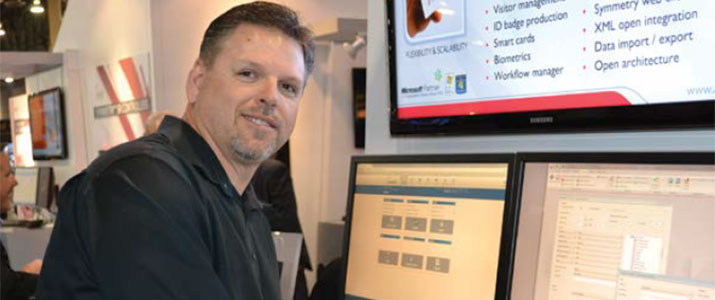
True Integration
Security professional combines experience, innovation and design
- By Rebecca Overton
- Jun 01, 2013
 Charlie Howell’s childhood was hardly
conventional. While other children
were reading comic books, he was poring
over repair manuals and installation
diagrams.
Charlie Howell’s childhood was hardly
conventional. While other children
were reading comic books, he was poring
over repair manuals and installation
diagrams.
As a boy in Ardmore, Okla., Howell helped his
dad build the houses their family lived in. When
Howell was 9 years old, his father owned an automotive
repair garage, where his son spent the next
two years working on car engines. From the age of
11 to 13, Howell built his own car.
When Howell was 11, his father started an appliance
repair business, where his son learned how
to fix refrigerators, dryers, air conditioners and
radios. Two years later, his dad decided Howell
would be his after-hours service technician, so the
teenager repaired customers’ appliances on weekends
and at night.
He enjoyed the look of surprise he received
when he knocked on a customer’s door, his toolbag
in hand. “When they answered, they’d see this
14-year-old kid and look around me for the repairman.
They thought I was an assistant,” he recalled
with a laugh.
Howell got his first taste of security work during
high school when the local Walmart hired him
to chase shoplifters. “They had a position for a
‘Code 99 guy,’” he explained. “When they thought
a shoplifter was on the premises, they’d issue a
Code 99 and I’d go after them.”
After attending college for a time, “I found out
I didn’t want to be an accountant,” Howell said,
but it didn’t take long for him to land another security job. In 1989, while coaching
a T-ball team in Chickasha, Okla.,
he was offered a technician position
by the owners of Star Alarm,
the team’s sponsor. For the next 20
years, the 44-year-old Howell played
in the security game.
After working as an integrator/
consultant for companies that include
ADT and Siemens, in 2003
he started a security consulting and
design firm near Sacramento, Calif.,
which specialized in water and wastewater
systems, commercial property,
and energy and transportation projects.
Howell also supported Department
of Defense SCIF rooms, created
vulnerability assessments and emergency
response plans, and designed
security systems for the California
Attorney General’s Office and the
vault of the California State Treasurer.
In May 2013, Howell joined
Combs Consulting Group (CCG), an
independent IT and security design
company headquartered in San Antonio,
Texas, where, as a consultant,
he is applying his experience, design
and innovation skills. With an
unusual ability to understand, create
and coordinate solutions with a
variety of agencies, Howell is a true
integrator in every sense of the word,
said Paul Sensibaugh, who served as
general manager of the Mountain
House (Calif.) Community Services
District for 11 years.
Howell worked on a variety of
projects for Mountain House from
2006 to 2012. Sensibaugh met him
when the district was building a
wastewater treatment plant.
“We had some communication
problems in the system,” Sensibaugh
explained. “Everyone was spinning
their wheels. We had six different
people from six different agencies
who kind of knew their things, but
nobody was coordinating everything
together.
“When I had a meeting with all
the consultants, Charlie seemed to be
the only guy in the room who really
understood the language that everyone
was talking. He can solve a variety
of problems. It got to the point
that we just put Charlie in our annual
budget every year.”
Figuring It Out
From almost the beginning, the security
field was a star in Howell’s galaxy.
While talking with him after the Tball
game in Oklahoma, Star Alarm’s
owners recognized a kindred spirit in
Howell. The company’s owners were
John Gearhart, a doctor and electrical
engineer, and Jim Clark, a teacher
who was fascinated by construction.
“They loved to look at electronics
magazines, find products they liked,
and sell and install them,” Howell said.
“After I worked for them part-time for
a month, they offered me a full-time
position. I was their first employee.”
Howell learned the business from
the ground up. After initially installing
security alarms on weekends, the
company expanded to provide central
vacuum systems, card access systems,
fire alarms and phone systems. When
Star Alarm won a bid for a phone system installation for an 83-room hotel
in Branson, Mo., Gearhart and Clark
turned it over to Howell.
“I learned the most I have ever
learned from that company,” Howell
said. “I’d talk with the manufacturer
to learn the concept behind
the product and how it worked. Star
Alarm’s method of operation was, ‘If
we want it, we’ll sell it, and Charlie
will figure it out.’”
As the company grew, so did the
number of its employees. Howell
was a branch manager when he was
26 years old. When he installed a security
system for Chickasha Chief of
Police Danny Sterling, the lawman
asked him a question that changed
Howell’s life.
“His first question to me—and
I’ve never forgotten it—was, ‘How do
you know where to put the devices?’
I said, ‘It’s kind of simple. You have
a front door, back door, some windows,
and motion detectors across
the front of your house.’
“But he said, ‘How do you know
that’s going to actually thwart the
criminal or just delay them? What’s
the concept?’ I said, ‘That’s a good
question. You’re the chief of police.
Let’s go find out.’”
Howell studied police cases to
learn the methods that criminals
used so he could determine how they
successfully gained access into properties.
After he understood how they
thought, he began to design systems
that deterred them. “I put my bad
guy hat on. If I can figure out how
he did it, I can figure out how to stop
him,” Howell said.
Howell worked for Star Alarm
from 1989 to 1996, then moved to
Oklahoma City to accept a job with
ADT as a residential installer and
quickly moved up the corporate ladder.
He won an award as a top technician,
became a troubleshooter, and
was transferred to San Jose, Calif.,
where he served as a service manager.
While providing security support
for DoD SCIF (Sensitive Compartmented
Information Facility) rooms,
Howell had another epiphany that
changed his career.
“That’s where I discovered the
second factor,” he said. ”We all had
this ‘peace of mind’ security attitude,
where you set up alarms and it was
just a checkbox for an insurance
company. But when I was working
on SCIF rooms, I realized what real
security is.
“It wasn’t meeting sales quotas for
service techs. I decided I can’t affect
the industry and my clients by sitting
in this role. I need to be a designer or
play a role in design with the client’s
needs in mind. I’m talking about
keeping bad guys from getting in.”
Turning Point
After changing his focus, Howell accepted
a position with Cardkey as
an applications engineer. Next came
a year-long stint with Siemens as a
project manager, project engineer
and field technician trainer. In July
2001, he joined Security by Design,
an independent security management
consulting and design engineering firm, as a consultant, where he learned
the importance of assessment methodologies. He
became the company’s vice president.
After 9/11, Howell provided a vulnerability assessment
of a national icon in San Francisco, and
protected it by leveraging what he had learned.
Another vulnerability assessment—for a statewide
water project for California—provided another
turning point in his career.
After implementation of the Bioterrorism Act
of 2002, Howell recognized that many small-tomedium-
sized water districts couldn’t afford a
security director or team to create vulnerability assessments
and emergency management responses.
“I saw this opportunity and decided to start
my own business, Security Concepts and Planning
(SCP), to focus on the water and wastewater industries,”
he said. “I didn’t think I’d be rich, but I could
make enough money to live on. I believe there is a
‘greater good’ principle here, helping these systems
protect their drinking water for their ratepayers.”
The message resonated within the industry.
For some of his projects, Howell broke into water
systems to discover their vulnerabilities, then
designed his way out. His clients included the
San Bernardino Valley Municipal Water District
and Mountain House, for whom he worked for
six years.
Located on the west side of the San Joaquin Valley
and about an hour from San Francisco, Mountain
House uses a variety of innovative technologies
to provide its residents with environmentally
friendly services. The district is a self-sufficient
community that was built from scratch. In 2003,
its population consisted of three people who lived
on farmland. By 2010, its population had grown to
10,000 and is expected to increase to 44,000.
Howell quickly became the “go-to guy” for a variety
of Mountain House projects that ranged from
water and wastewater treatment plant security, to
cybersecurity, to solving thefts of copper in streetlights
in the district.
“Charlie was a specialist, no doubt, but he
seemed to have several specialties,” Sensibaugh said.
“He always seemed to come up with the reasonable
thing to try, and most of them worked. He has a
thirst for knowledge and the ability to apply it.”
Sensibaugh recalled an unusual—and humorous—
situation at the water treatment plant that
Howell managed to solve immediately, perhaps by
returning to his Oklahoma roots.
“We have high security around our water
treatment plant, but when the operators went
out there one morning, there were these sheep all
over the plant grounds, so they called Charlie,”
Sensibaugh said.
“Charlie looked around and sure enough, there
was a wrought iron fence with a hole in it behind
some bushes. Charlie took one of the sheep and led
it back through the hole. Of course, he knew the
other sheep would follow it, and they did.”
Howell’s projects in California continued to
grow, including security systems for the Rancho
Cordova City Council and an administrative
building for San Joaquin County. His professional
journey has taken him most recently to Texas and
Combs Consulting Group, where school security
is a core industry.
As the father of an 8-year-old daughter, Howell
is passionate about school safety and has developed
a secured classroom that includes invisible
elements to protect teachers and students.
“Security is the thing that wakes me up in the
morning,” he said. “It drives me and makes me
want to go to work.”
This article originally appeared in the June 2013 issue of Security Today.